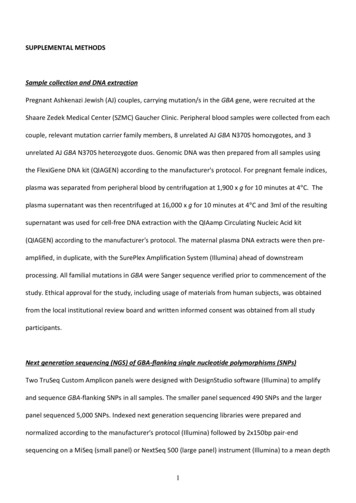
Transcription
Indexed Sequencingon Illumina SystemsILLUMINA PROPRIETARYDocument # 15057455 v09April 2021For Research Use Only. Not for use in diagnostic procedures.
Indexed Sequencing OverviewThis document and its contents are proprietary to Illumina, Inc. and its affiliates ("Illumina"), and are intended solely forthe contractual use of its customer in connection with the use of the product(s) described herein and for no otherpurpose. This document and its contents shall not be used or distributed for any other purpose and/or otherwisecommunicated, disclosed, or reproduced in any way whatsoever without the prior written consent of Illumina. Illuminadoes not convey any license under its patent, trademark, copyright, or common-law rights nor similar rights of any thirdparties by this document.The instructions in this document must be strictly and explicitly followed by qualified and properly trained personnel inorder to ensure the proper and safe use of the product(s) described herein. All of the contents of this document must befully read and understood prior to using such product(s).FAILURE TO COMPLETELY READ AND EXPLICITLY FOLLOW ALL OF THE INSTRUCTIONS CONTAINED HEREIN MAYRESULT IN DAMAGE TO THE PRODUCT(S), INJURY TO PERSONS, INCLUDING TO USERS OR OTHERS, AND DAMAGETO OTHER PROPERTY, AND WILL VOID ANY WARRANTY APPLICABLE TO THE PRODUCT(S).ILLUMINA DOES NOT ASSUME ANY LIABILITY ARISING OUT OF THE IMPROPER USE OF THE PRODUCT(S) DESCRIBEDHEREIN (INCLUDING PARTS THEREOF OR SOFTWARE). 2021 Illumina, Inc. All rights reserved.All trademarks are the property of Illumina, Inc. or their respective owners. For specific trademark information, seewww.illumina.com/company/legal.html.Document # 15057455 v09For Research Use Only. Not for use in diagnostic procedures.ii
Indexed Sequencing OverviewRevision HistoryDocumentDocument # 15057455DateDescription of ChangeApril 2021Added HTML format.Updates made to support the MiniSeq Standardv08November2020Document # 15057455July 2020Updates made to support the NovaSeq 6000 v1.5v09Document # 15057455v07Document # 15057455reagent kit introduction.March 2020v06Document # 15057455and Rapid reagent kits.Modified NextSeq Systems reference to accountfor all versions.Added Instrument Run Setup to introduction.March 2019v05Renamed the two dual-indexed workflows on apaired-end flow cell: Renamed workflow A to the forward strandworkflow. Renamed workflow B to the reversecomplement workflow.Updated cycles per Index Read for all dual-indexworkflows (except forward strand) to eight or 10.Updated the descriptions of single- and dualindexed libraries.Corrected the Index 1 primer for the HiSeq3000/4000 SR Cluster Kit, HiSeq SR Cluster Kitv4, and HiSeq PE Cluster Kit v4 to HP12.Document # 15057455v04FebruaryAdded the iSeq 100 and HiSeq X flow cells to2018workflow B for dual-indexing on a paired-endflow cell.Added the IDT for Illumina TruSeq UD Indexescombinations for dual-indexed libraries.Document # 15057455 v09For Research Use Only. Not for use in diagnostic procedures.iii
Indexed Sequencing OverviewDocumentDocument # 15057455v03DateFebruary2017Description of ChangeUpdated for the NovaSeq Series: Added the NovaSeq 5000/6000 Flow Cell toworkflow A for dual-indexing on a paired-endflow cell. For workflow A, increased the number ofcycles in an Index Read to a maximum of 20.Updated how many uniquely tagged libraries canbe generated: Up to 48 single-indexed libraries. Up to 384 dual-indexed libraries.Clarified that this guide is applicable to all Illuminasequencing systems.Document # 15057455March 2016v02Added the MiniSeq system, which follows thesingle-index workflow and Workflow B for dualindexing on a paired-end flow cell.Renamed this guide to Indexed SequencingOverview Guide to emphasize indexing oversystems.Organized dual-indexing workflows on pairedend flow cells as Workflow A and Workflow B.Organized dual-indexing workflows on singleread flow cells by sequencing system.Document # 15057455v01August2015Added the dual-indexed workflow for a HiSeq3000/4000 SR flow cell.Added sequencing primers available in the HiSeq3000/4000 SR Cluster Kit.Part # 15057455 Rev.BFebruary2015Added the HiSeq 3000/4000 flow cell to thedual-indexed workflow that performs the Index 2Read after Read 2 resynthesis. This workflow isperformed on NextSeq, HiSeq 4000, and HiSeq3000.Added sequencing primers available in the HiSeq3000/4000 PE Cluster Kit.Document # 15057455 v09For Research Use Only. Not for use in diagnostic procedures.iv
Indexed Sequencing OverviewDocumentPart # 15057455 Rev.DateJuly 2014Description of ChangeInitial release.ADocument # 15057455 v09For Research Use Only. Not for use in diagnostic procedures.v
Indexed Sequencing OverviewTable of ContentsRevision HistoryIntroductionSingle-Indexed Sequencing OverviewDual-Indexed Sequencing OverviewDual-Indexed Workflow on a Paired-End Flow CellDual-Indexed Workflow on a Single-Read Flow CellSequencing Primers for HiSeq SystemsDocument # 15057455 v09For Research Use Only. Not for use in diagnostic procedures.iii1233686
Indexed Sequencing OverviewIntroductionThis documentation provides an overview of indexed sequencing for Illumina sequencing systems.Indexed sequencing is a method that allows multiple libraries to be pooled and sequenced together.Indexing libraries requires the addition of a unique identifier, or index sequence, to DNA samples duringlibrary preparation. BaseSpace Sequence Hub, Local Run Manager, Instrument Run Setup, or bcl2fastq2Conversion Software process these tags to identify each uniquely tagged library for downstreamanalysis.The number of index sequences added to samples differs for single-indexed and dual-indexedsequencing. Single-indexed libraries—Adds Index 1 (i7) sequences to generate uniquely tagged libraries. Dual-indexed libraries—Adds Index 1 (i7) and Index 2 (i5) sequences to generate uniquely taggedlibraries.–Unique dual (UD) indexes have distinct, unrelated index adapters for both index reads. Indexadapter sequences are eight or 10 bases long.–Combinatorial dual (CD) indexes have eight unique dual pairs of index adapters, so mostlibraries share sequences on the i7 or i5 end. Index adapter sequences are eight bases long.During indexed sequencing, the index is sequenced in a separate read called the Index Read, where anew sequencing primer is annealed. When libraries are dual-indexed, the sequencing run includes twoadditional reads, called the Index 1 Read and Index 2 Read.Document # 15057455 v09For Research Use Only. Not for use in diagnostic procedures.1
Indexed Sequencing OverviewSingle-Indexed SequencingOverviewThe single-indexed sequencing workflow applies to all Illumina sequencing platforms, where an IndexRead follows Read 1.Figure 1 Single-Indexed Sequencing1.Read 1—Read 1 follows the standard Read 1 sequencing protocol using SBS reagents. The Read 1sequencing primer is annealed to the template strand during the cluster generation step.2. Index Read preparation—The Read 1 product is removed and the Index 1 (i7) sequencing primer isannealed to the same template strand, producing the Index 1 (i7) Read.3. Index 1 (i7) Read—Following Index Read preparation, the Index 1 (i7) Read is performed. The readlength depends on the system and run parameters.4. Read 2 resynthesis—The Index Read product is removed and the original template strand is used toregenerate the complementary strand. Then, the original template strand is removed to allowhybridization of the Read 2 sequencing primer.5. Read 2—Read 2 follows the standard paired-end sequencing protocol using SBS reagents.Document # 15057455 v09For Research Use Only. Not for use in diagnostic procedures.2
Indexed Sequencing OverviewDual-Indexed Sequencing OverviewDual-indexed sequencing includes two index reads after Read 1: the Index 1 Read and the Index 2 Read.Sequencing kits for HiSeq systems are available with a single-read or paired-end flow cell. For all othersystems, sequencing kits include a paired-end flow cell.The control software performs Read 1, any index reads, and then Read 2 based on the parametersprovided for the run in the sample sheet or during run setup.For all indexing workflows, the Index 1 Read directly follows Read 1. However, for dual-indexing on apaired-end flow cell, the rest of the workflow differs: Forward strand—The Index 2 Read occurs before Read 2 resynthesis, so the Index 2 (i5) adapter issequenced on the forward strand. Reverse complement—The Index 2 Read occurs after Read 2 resynthesis, which creates thereverse complement of the Index 2 (i5) index adapter sequence.Table 1 Dual-Index Paired-End Sequencing WorkflowsForward StrandReverse ComplementRead 1Read 1Index Read preparationIndex Read preparationIndex 1 ReadIndex 1 ReadIndex 2 ReadRead 2 resynthesisRead 2 resynthesisIndex 2 ReadRead 2Read 2 preparationRead 2Dual-Indexed Workflow on a Paired-End Flow CellDual-index sequencing on a paired-end flow cell follows one of two workflows, depending on thesystem and software: The forward strand workflow is performed on the NovaSeq 6000 with v1.0 reagent kits, MiniSeqwith Rapid Reagent kits, MiSeq, HiSeq 2500, and HiSeq 2000.Document # 15057455 v09For Research Use Only. Not for use in diagnostic procedures.3
Indexed Sequencing Overview The reverse complement workflow is performed on the iSeq 100, MiniSeq with Standard reagentkits, NextSeq Systems, NovaSeq 6000 with v1.5 reagent kits, HiSeq X, HiSeq 4000, andHiSeq 3000.Forward Strand WorkflowThe chemistry applied to the Index 2 Read during a paired-end, dual-indexed run on the NovaSeq 6000with v1.0 reagent kits, MiniSeq with rapid reagent kits, MiSeq, HiSeq 2500, or HiSeq 2000 System isspecific to the paired-end flow cell. Reading the i5 index requires seven additional chemistry-onlycycles. This step uses the resynthesis mix, a paired-end reagent, during the Index 2 Read process.While MiniSeq Rapid reagents allow for dual indexing, Read 2 cannot be performed with theMiniSeq Rapid reagent kit.Figure 2 Dual-Indexed Sequencing on a Paired-End Flow Cell (Forward Strand)1.Read 1—Read 1 follows the standard Read 1 sequencing protocol using SBS reagents. The Read 1sequencing primer is annealed to the template strand during the cluster generation step.2. Index Read preparation—The Read 1 product is removed and the Index 1 (i7) sequencing primer isannealed to the same template strand.3. Index 1 (i7) Read—Following Index Read preparation, the Index 1 (i7) Read performs up to 20 cyclesof sequencing.The maximum number of cycles in each Index Read depends on the system and runparameters.4. Index 2 (i5) Read—The Index 1 (i7) Read product is removed and the template anneals to thegrafted P5 primer on the surface of the flow cell. The run proceeds through an additional sevenchemistry-only cycles (no imaging occurs), followed by up to 20 cycles of sequencing.Document # 15057455 v09For Research Use Only. Not for use in diagnostic procedures.4
Indexed Sequencing Overview5. Read 2 resynthesis—The Index Read product is removed and the original template strand is usedto regenerate the complementary strand. The original template strand is then removed to allowhybridization of the Read 2 sequencing primer.6. Read 2—Read 2 follows the standard paired-end sequencing protocol using SBS reagents.Reverse Complement WorkflowA dual-indexed run on the iSeq 100, MiniSeq with standard reagent kits, NextSeq Systems, NovaSeq6000 with v1.5 reagent kits, HiSeq X, HiSeq 4000, or HiSeq 3000 System performs the Index 2 Readafter Read 2 resynthesis. This workflow requires a reverse complement of the Index 2 (i5) primersequence compared to the primer sequence used on other Illumina platforms.The Index 2 sequencing primer is part of the dual-indexing primer mix for the iSeq 100, MiniSeq withstandard reagent kits, NextSeq Systems, and NovaSeq 6000 with v1.5 reagent kits. For the HiSeq X,HiSeq 4000, and HiSeq 3000 Systems, the Index 2 sequencing primer is part of HP14. HP14 is anindexing primer mix that contains primers for both index reads.Figure 3 Dual-Indexed Sequencing on a Paired-End Flow Cell (Reverse Complement)1.Read 1—Read 1 follows the standard Read 1 sequencing protocol using SBS reagents. The Read 1sequencing primer is annealed to the template strand during the cluster generation step.2. Index Read preparation—The Read 1 product is removed and the Index 1 (i7) sequencing primer isannealed to the same template strand.3. Index 1 (i7) Read—Following Index Read preparation, the Index 1 (i7) Read performs eight or 10cycles of sequencing.4. Read 2 resynthesis—The Index 1 Read product is removed and the original template strand is usedto regenerate the complementary strand. Then the original template strand is removed to allowhybridization of the Index 2 (i5) sequencing primer.5. Index 2 (i5) Read—Following Read 2 resynthesis, the Index 2 (i5) Read performs eight or 10 cyclesof sequencing.This workflow does not require seven additional chemistry-only cycles.Document # 15057455 v09For Research Use Only. Not for use in diagnostic procedures.5
Indexed Sequencing Overview6. Read 2 preparation—The Index 2 Read product is removed and the Read 2 sequencing primer isannealed to the same template strand.7. Read 2—Read 2 follows the standard paired-end sequencing protocol using SBS reagents.Dual-Indexed Workflow on a Single-Read Flow CellSingle-read sequencing is possible on all HiSeq systems. Dual-index sequencing on a single-read flowcell follows one of two workflows, depending on the system.HiSeq 4000 and HiSeq 3000 SystemsThe chemistry applied to the Index 2 Read during a single-read dual-indexed run on the HiSeq 4000 orHiSeq 3000 System is specific to the single-read flow cell. Reading the i5 index requires sevenadditional chemistry-only cycles. This step uses the resynthesis mix during the Index 2 Read.Figure 4 Dual-Indexed Sequencing on a Single-Read Flow Cell (HiSeq 4000 or HiSeq 3000)1.Read 1—Read 1 follows the standard Read 1 sequencing protocol using SBS reagents. The Read 1sequencing primer is annealed to the template strand during cluster generation.2. Index Read preparation—The Read 1 product is removed and the Index 1 (i7) sequencing primer isannealed to the same template strand.3. Index 1 (i7) Read—Following Index Read preparation, the Index 1 (i7) Read performs eight or 10cycles of sequencing.4. Index 2 (i5) Read—The Index 1 (i7) Read product is removed and the template anneals to thegrafted P5 oligo on the surface of the flow cell. The run proceeds through seven chemistry-onlycycles (no imaging occurs), followed by eight or 10 cycles of sequencing.Document # 15057455 v09For Research Use Only. Not for use in diagnostic procedures.6
Indexed Sequencing OverviewHiSeq 2500 and HiSeq 2000 SystemsThe chemistry applied to the Index 2 Read during a single-read, dual-indexed run on the HiSeq 2500 orHiSeq 2000 System is specific to the single-read flow cell. Performing the Index 2 Read on a HiSeqsingle-read flow cell requires HP9, an Index 2 sequencing primer.Figure 5 Dual-Indexed Sequencing on a Single-Read Flow Cell (HiSeq 2500 or HiSeq 2000)1.Read 1—Read 1 follows the standard Read 1 sequencing protocol using SBS reagents. The Read 1sequencing primer is annealed to the template strand during the cluster generation step.2. Index Read preparation—The Read 1 product is removed and the Index 1 (i7) sequencing primer isannealed to the same template strand.3. Index 1 (i7) Read—Following Index Read preparation, the Index 1 (i7) Read performs eight or 10cycles of sequencing.4. Index 2 (i5) Read—The Index 1 (i7) Read product is removed and the Index 2 (i5) sequencing primeris annealed to the same template strand. The run proceeds through eight or 10 cycles ofsequencing.This workflow does not require seven additional chemistry-only cycles.Document # 15057455 v09For Research Use Only. Not for use in diagnostic procedures.7
Indexed Sequencing OverviewSequencing Primers for HiSeqSystemsIndexing workflow differences require system-specific chemistry and sequencing primers. Thefollowing tables list available HiSeq reagent kits and the associated sequencing primers, which are usedwith each step of an indexed run.Sequencing primers for all other systems are provided in the prefilled reagent cartridge.Sequencing Primers in Cluster KitsRun TypeRead 1Index 1 (i7)Index 2 (i5)Read 2HiSeq 3000/4000 PE ClusterHP10HP14HP14HP11HP10HP12--¹--HiSeq PE Cluster Kit v4HP10HP12--¹HP11HiSeq SR Cluster Kit v4HP10HP12HP9--TruSeq PE Cluster Kit v3HP6HP8--¹HP7TruSeq SR Cluster Kit v3HP6HP8--²--KitHiSeq 3000/4000 SR ClusterKit¹ The Index 2 Read uses resynthesis mix.² The TruSeq Dual Index Sequencing Primer Box for single reads is required for dual-indexed sequencing on asingle-read flow cell, regardless of library type.Additional Primers for the TruSeq Cluster Kit v3Using the TruSeq Cluster Kit v3 to sequence any Nextera libraries except Nextera Mate Pair librariesrequires the TruSeq Dual Index Sequencing Primer Box. Sequencing primers in TruSeq v3 kits are notcompatible with most Nextera libraries, while sequencing primers provided in the TruSeq Dual IndexSequencing Primer Box are compatible with all library types. To confirm primer compatibility, see thedocumentation for the library prep kit.Dual-indexed sequencing on a single-read flow cell requires the single-read kit, regardless of thelibraries being sequenced.Document # 15057455 v09For Research Use Only. Not for use in diagnostic procedures.8
Indexed Sequencing OverviewRun TypeRead 1Index 1 (i7)Index 2 (i5)Read 2TruSeq PE Dual IndexHP10HP12--¹HP11HP10HP12HP9--Sequencing Primer Box(For use with paired-end flowcells)TruSeq SR Dual IndexSequencing Primer Box(For use with single-read flowcells)¹ The resynthesis mix, a paired-end reagent provided in the TruSeq PE Cluster Kit v3, is used to perform the Index2 Read.Document # 15057455 v09For Research Use Only. Not for use in diagnostic procedures.9
Document # 15057455 v09Illumina5200 Illumina WaySan Diego, California 92122 U.S.A. 1.800.809.ILMN (4566) 1.858.202.4566 (outside North r Research Use Only. Not for use in diagnostic procedures. 2021 Illumina, Inc. All rights reserved.
2.Index Read preparation—The Read 1 product is removed and the Index 1 (i7) sequencing primer is annealed to the same template strand. 3.Index 1 (i7) Read—Following Index Read preparation, the Index 1 (i7) Read performs up to 20 cycles of sequencing. The maximum number of cycles in each Index Read depends on the system and run parameters.










